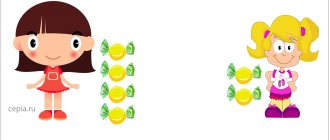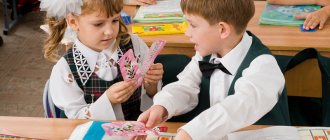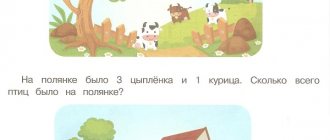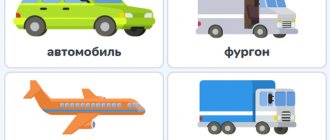Preparing a child for school - developing memory, perseverance and hand motor skills
The age of 6–7 years for a child is most often called one of the most difficult. At this age, our child not only learns to enter into social relationships with society, but also at this stage the child’s cognitive abilities are formed. An important aspect is preparing the child for school. To do this, you should pay attention to tasks to prepare for school, developing memory, perseverance, and hand motor skills. This is necessary in order to subsequently learn to write letters and numbers correctly and confidently and to teach the child to read correctly and quickly. It is very important to know and understand that the child will give preference to the most interesting and memorable tasks, that is, your main goal will be not only to guide your child in the right direction, but also to make the cognitive process bright and colorful.
Why and how much should you exercise in the summer?
Any written exercise should last 20-30 minutes, after which you need to take a break. It is recommended to spend at least 30 minutes on literary reading. Educational games and logic tasks can be completed at will at any time without restrictions.
Tasks for first graders recommended for completion during the summer holidays:
| Russian language (writing) |
|
| Mathematics |
|
| Literary reading | List of works to read. |
| Logics | Logic exercises (development of sequential thinking, the structure of which, through reasoning, leads to the correct conclusion). |
How to prepare your child for school
What to do when a child does not want to study? How to prepare a child for school? Psychologists offer several methods to solve this problem. Many experienced mothers note the “game” method, that is, providing the child with tasks in a playful, entertaining form.
Doctors advise taking occasional breaks that include physical activity and eye exercises. You should not ignore “moving minutes”, since the child is not used to sitting in one place. Thanks to this approach, the preschooler will know that preparing for school is a fun process that he wants to return to again and again.
However, you should remember that you should not overdo it and give your child a lot of exercises to prepare for school. Everything should be in moderation. Also, do not force your child to do any task if he does not want to. It is worth first identifying the cause of the reluctance, and then trying to eliminate it. The future schoolchild should also understand that studying for school is a very responsible and sometimes time-consuming process, but if desired, it can be dealt with. The main thing is to encourage and encourage the child not only with words, but also with pleasant little surprises. “Learning is fun.” This is exactly how the process needs to be presented to a preschooler, and then preparation for first grade will not cause reluctance and rejection in the child to study.
Registration for 1st grade: 17 questions and tasks for testing
When enrolling a child in first grade, parents inevitably think about their son or daughter’s readiness to study. We will try to briefly formulate the skills and abilities that any child must have in order to enter a normal, mass school and successfully adapt to the learning process at its primary level.
So, a child entering school must:
- Be able to identify yourself (full name, patronymic, last name). Be able to fully name your mother, father, and grandmother.
- Know the seasons, the number and names of months in the year, days in the week. Know what time of year it is, what month it is, what day it is. Be able to answer questions like “When do birds fly south?”, “When it’s cold and snowing?”, “On what day do people rest and don’t go to work?”, “At what time of year do the leaves turn yellow and fall?”, “ When do we pick mushrooms and berries?” etc.
- Be able to read (syllable by syllable) a small and very simple text of several sentences.
- Be able to write (or copy) a simple phrase. For example: “He was eating soup,” “Misha was washing the window.”
- Direct and reverse counting within twenty (1, 2...20; 20, 19...1).
- Be able to add and subtract numbers within the first ten.
- Possess the skill of generalization based on characteristics. That is, from the proposed pictures, the child should be able to choose those that have something in common. For example, if pictures with a tram, a wheel, an apple, a cat and a bus are offered, then the child should put the tram and bus aside and say that these are transport or means of transportation, or “people ride on them.” If a number of words are offered: “shoes, boots, slippers,” then the child must choose a word that applies to them all. In this case, the word is “shoes.”
- Possess the skill of exclusion from the series. A number of words are suggested: “cheese, butter, plasticine, sausage.” The child must not only exclude the “superfluous” word “plasticine”, but also (most importantly!) explain why it is he who is superfluous. “Plasticine is superfluous because it is used to sculpt. It's inedible. And everything else is food. They eat her."
- Find similarities and differences between objects.
- What do carrots and potatoes have in common?
- They are both vegetables, they are eaten, they are used to make soup, they grow in the ground, they have peels, etc.
- How are they different from each other?
- They differ in shape. The carrots are triangular, and the potatoes are round or oval. They also differ in color. The carrots are orange and the potatoes are brown.
- Be able to compose a story based on a picture or a series of pictures. In some schools, children are asked to first arrange the pictures in the right order, and then tell a story based on them. The story must be coherent, have a beginning and an end. It is highly encouraged to at least mention the emotional state of the characters (“In this picture the girl is sad because her ball flew away”, “The boy was very offended”, “The children were happy that a slide was built for them”, etc.)
- Know the basic geometric shapes (circle, oval, triangle, square, rectangle) and see their combinations (in this picture there are two triangles and one square). Be able to draw them.
- Remember 5–7 out of 10 clearly named simple words.
- Remember and name at least six of 12 pictures simultaneously shown to the child for 30 seconds.
- Be able to recite a short poem by heart at the teacher’s request.
- Be able to answer questions like “What comes first: lunch or dinner? Spring or summer?”, “Who is bigger: a cow or a goat? Bird or bee?”, “The cow has a baby - a calf. What about the horse?
- Know 10–12 primary colors.
- Be able to draw a human figure with all the main parts of the body (including neck, fingers, etc.).
Most schools do not currently test for admission. There are also educational institutions for which this list of skills will be too short or simple. What we have listed is the basic level: if it exists, it means that the child is, in principle, able to study and master the primary school curriculum.
Developmental practical tasks to prepare a child for school
Developmental tasks for children do not have to be difficult or expensive. We understand perfectly well that the need to offer a child new tasks every day is a certain necessity for a modern mother, so we invite you to use our services - download free practical tasks to prepare for school. Their advantages:
1) Variety of tasks. This is very important, because the same type of exercises weakens the child’s interest. It is necessary to diversify your activities every day. Preparing for school tasks should be interesting and exciting for the child. Psychologists also recommend rewarding a child for correctly performing an exercise to prepare for school.
2) The tasks are aimed at different types of mental activity - the development of motor skills, the development of logic, the development of thinking in children 6-7 years old.
3) Subsequently, the child himself will be able to complete practical tasks and even submit them to you “for testing,” which will further prepare him for the school learning process.
The main thing is to remember that the desire to learn is instilled in a child in childhood. Preparing for school and practical tasks from childdevelop are always interesting, not difficult and exciting.
Mathematics
A set of mathematics tasks contains basic exercises for subsequent mastery of a more complex program in the next academic year.
Composition of numbers (up to 20)
Basic tasks in mathematics are aimed at knowing the composition of numbers. This will help first-graders reduce the time spent calculating examples and solving problems, so it is necessary to repeat and consolidate the skills acquired during the school year.
For example:
Tens and units (writing in numbers)
Write down the number in which:
- 2 tens and 3 ones (23);
- 4 tens and 2 units;
- 7 tens and 1 unit;
- 5 tens and 4 units;
- 1 ten and nine ones;
Mathematical rules
A first-grader needs to know by heart and understand all the mathematical rules covered during the school year, so they should be repeated and consolidated.
It is important to remember the following:
- The numbers obtained by counting are called natural numbers. 0 is not a natural number.
- A line that ends at the point from which it originated is called closed.
- Addition rule: 1 term + 2 terms = sum value.
- Changing the places of the terms does not change the value of the sum.
- Subtraction rule: minuend – subtrahend = difference value;
- 8+7; 12-9; are mathematical expressions in which numbers are combined by action signs.
- If one of the terms is 0, the value of the sum will be equal to the other term.
- If you subtract any of the terms from the sum value, you get the remaining term.
- Numbers from 1 to 9 are single digits.
- Numbers from 10 to 99 are two-digit.
- To increase a number by the required number of units, the action of addition is performed.
- To reduce a number by the required number of units, a subtraction action is performed.
- To calculate how much the required number is greater or less than another number, you need to subtract the smaller number from the larger number.
Problems on the topic: “how much more” and “how much less”
For example:
- The first basket contains 4 apples, and the second basket contains 7 apples. How many more apples are in the second basket than in the first?
- Masha has 6 candies, and Misha has 3 candies. How many fewer candies does Misha have than Masha?
Addition and subtraction problems
For example:
- The first jug contains 2 liters of juice, and the second jug contains 4 liters more juice. How many liters of juice are in the second jug?
- There are 12 roses in one flowerbed, and 3 fewer roses in the other. How many roses are there in the other flowerbed?
Examples for addition and subtraction
Such as:
9-4=?7+2=?7+4-2=?
8-4=?8+6=?9-2+6=?
Comparison of numbers and comparison examples (equalities and inequalities)
Use the signs >,< or =.
4_616_182+3_1+4
8_515_159-3_7-2
Single and multi-digit numbers
Write down a few single-digit numbers and a few double-digit ones.
Math assignments for first graders will help your child develop logic.
For example:
- 3,8,9.
- 12,17,20.
Composing examples with a specific number
Compose and write down several examples with answers: 8, 12, 17.
For example: 4+4=8; 5+7=12; 10+7=17.
Putting the correct signs in examples
17_7=1012_2=1413_4=9
21_2=1914_5=1911_6=17
Segments
You need to do the following:
- Draw one segment 12 cm long, the other 3 cm shorter.
- Draw the first segment 4 cm long, the second 3 cm longer, the third 2 cm shorter than the second.
Centimeters, decimeters and meters
You can do the following:
- Draw a segment 1 dm and 3 cm long, another 2 dm less.
- Draw a segment 2 dm long, another 11 cm shorter.
- Draw a segment 3 cm long, another 1 dm and 4 cm longer.
At what age should preparatory classes begin?
By about 3 years of age, a child can already consciously perceive the simplest mathematical terms, so it is from this age that preparatory classes can begin. Their first stage is the introduction of the concepts “few-many”, “one-several”. After the preschooler has formed a quantitative understanding, he can begin to study numbers.
It’s worth starting with the first two ordinal numbers – one and two. It will be easier to remember them if parents give clear examples - they explain to the child that he has one mouth or nose, but there are two arms, legs, ears, and eyes. This will not only make it easier for the baby to remember the numbers presented, but also easier to learn how to compare them with the number of objects. Later, using the same principle, it is worth studying all other numbers within ten.
Despite the fact that learning numbers and ordinal counting does not seem like a difficult task, even such basic mathematical knowledge must be instilled correctly. Let's look at the most basic recommendations that you should follow.
What to pay attention to - tips for parents
Children of preschool and primary school age do not yet have a high level of perseverance and attentiveness, and therefore long and boring classes are not suitable for them. In addition, if the child is not interested in studying, then this affects both the quality of learning the material and the desire to study in the future. Therefore, in order not to overtire the child and reduce his motivation, it is better to use a game approach to learning. It will allow the preschooler to be involved in the lesson process and make the lessons fun.
In addition to the learning format, you need to monitor how the child compares his knowledge with the general picture of the world. If he studies numbers, then you need to ask him where he can see them in everyday life (on a calendar or watch dial, on TV, in a book, and so on). If a preschooler is learning the concepts of “right-left”, “higher-lower”, then you need to ask him simple questions about spatial orientation: “is the table to the right or left of you?”, “Who is taller - me or you?”
Similar examples of tasks are suitable for children under 5 years old and will help develop their skills. For future first-graders it is worth choosing other, more complex exercises.
Training attention
Each of us knows that paying attention in class is half the success in studying. Sometimes you don’t even have to read the textbook after listening carefully to the teacher.
To check whether your future first-grader is ready to do everything the first time, by carefully reading, counting and writing letters, tasks to find differences help.
These can be almost identical pictures, differing in the color of the elements or the set of details. In addition to pictures, you can use words where one or more letters are replaced to train attention.
Parents also often play the game “Turn around and name it,” when something is hidden, and the child remembers what is missing or is out of place.
On the ShkolaLa blog you will find five ready-made exercises that will help your child become attentive.
Let's help with motor skills
The development of fine motor skills begins from an early age and approaches the final stage during the school period, when the process of formation of those areas of the child’s brain that are responsible for the development of hand muscles ends.
You already know how to train your hand to write. If you haven’t come across it yet, read it, it’s written about useful things in an accessible and interesting way. Let me remind you that modeling and drawing, construction sets and applications made from different materials are effective for fine motor skills.
We reason logically
And where would we be today without logic, which is sometimes not very beloved by us, our parents, because all modern elementary school textbooks are riddled with it, this boring logic!
Among the logical tasks, the most common ones are finding the odd one out and combining them into groups based on common characteristics. So, for example, you can hide the name of a flower among the names of trees or place a berry among the fruits. By the way, these can be not only objects (nouns), but also their properties (adjectives).
Did you know that puzzles, so beloved by children, are great for training logic!
For more advanced students, you can suggest completing a sequence of pictures in which the last element is missing.
Baggage of knowledge for a first grader
Judging by the requirements of teachers, before entering school, every child must know:
- all or almost all information about yourself and your parents - full name, place of work, telephone numbers,
- coordinates where he lives - country, town, street, house and apartment number,
- names of other countries,
- names of animals, differences between domestic and wild animals, dividing them into categories, for example, a tit should not be a fish, but a bear should not be a bird,
- times of day, seasons and their sequence,
- names of the days of the week,
- main natural phenomena,
- color palette,
- professions of people.
Some schools even ask for basic rules of behavior on the road during testing. And besides this, we didn’t talk about reading, Russian and mathematics, as a matter of course! A lot, isn't it? How to remember everything and put it correctly in a child’s brain? For this purpose, various exercises have been developed, which children begin to perform in older groups of kindergarten and hone at home.
We think creatively
The ability to think creatively is again developed by pictures, from which children compose stories. Explaining words, especially incomprehensible ones, is a good way to train your thinking abilities - here there is room for children's imagination to run wild!
We have already devoted a lot of time and space to the process of creative thinking. We learned to think while playing, found seven books for developing children's thinking, we have as many as 10 golden developmental tasks for mental training, and now everyone knows what it is - the first step to great success.










